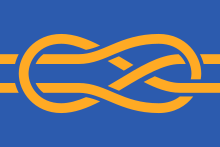Vexillology

Vexillology (/ˌvɛksɪˈlɒlədʒi/) is the study of the history, symbolism and usage of flags or, by extension, any interest in flags in general.[1] The word is a synthesis of the Latin word vexillum (which refers to a kind of square flag which was carried by Roman cavalry[2]) and the Greek suffix -logia ("study").[3] The first known usage of the word vexillology was in 1959.[4]
A person who studies flags is a vexillologist, one who designs flags is a vexillographer, and the art of flag-designing is called vexillography. One who is a hobbyist or general admirer of flags is a vexillophile.
History[]
This section needs expansion. You can help by . (March 2018) |
The study of flags, or vexillology, was formalized by the U.S. scholar and student of flags Whitney Smith in 1961 with the publication of The Flag Bulletin.[5] During his lifetime, Smith organized various flag organizations and meetings including the first International Congress of Vexillology (ICV), the North American Vexillological Association, and the International Federation of Vexillological Associations (FIAV).[6] Smith, who is acknowledged as conceiving the term "vexillology" in 1957, wrote "[w]hile the use of flags goes back to the earliest days of human civilization, the study of that usage in a serious fashion is so recent that the term for it ... did not appear in print until 1959."[7] Before this time, study of flags was generally considered a part of heraldry.
Involvement in vexillology includes academic work in fields such as sociology, history or design, professional or otherwise, contributions from the flag industry, and interest from those simply passionate about flags. ICV and local vexillological meetings often cover a wide range of interest in flags. Since 1969, an International Congress of Vexillology has been organized every two years under the auspices of FIAV; papers presented at an ICV are published afterwards as the Congress's Proceedings.[5]
Modern Interest[]
The study of vexillology and interest in flags in general has expanded onto the internet, with communities such as the subreddit r/vexillology having an influence over flag-related discussion online, along with flag-based information websites such as FOTW and Vexilla Mundi.
Communities based around flags have also sprung up on other social media websites, such as YouTube, Instagram and Twitter.
See also[]
- Glossary of vexillology
- Vexillological symbol
- Vexillum
- Vexilloid
- Flags of the World
- List of vexillologists
- Heraldry
- List of flags by design
- List of national flags by design
Further reading[]
- Leepson, Marc. Flag: An American Biography. New York: Thomas Dunne Books, 2005.
- Smith, Whitney. Flags Through the Ages and Across the World. New York: McGraw-Hill, 1975.
Marshall, Tim. "A Flag Worth Dying For: The Power and Politics of Flag." 2016.
References[]
- ^ Smith, Whitney. Flags Through the Ages and Across the World New York: McGraw-Hill, 1975. Print.
- ^ "Vexillum". www.merriam-webster.com. Merriam-Webster Dictionary. Retrieved 15 September 2020.
- ^ "About Vexillology - The Flag Institute". The Flag Institute. Retrieved 2018-06-01.
- ^ "Vexillology". www.merriam-webster.com. Merriam-Webster Dictionary. Retrieved 15 September 2020.
- ^ Jump up to: a b "CONSIDER VEXILLOLOGY. – SemiotiX". semioticon.com. Retrieved 2018-04-01.
- ^ Vulliamy, Elsa (December 15, 2015). "Which flag is it? Take our quiz to find out". Retrieved March 13, 2016.
- ^ "Vexillology". www.crwflags.com. Retrieved 2017-11-03.
External links[]
 Media related to Vexillology at Wikimedia Commons
Media related to Vexillology at Wikimedia Commons
- Vexillology

